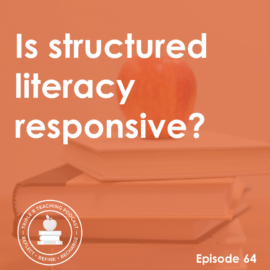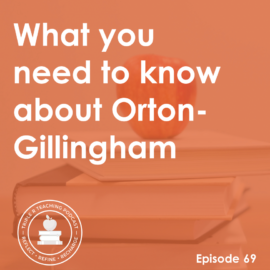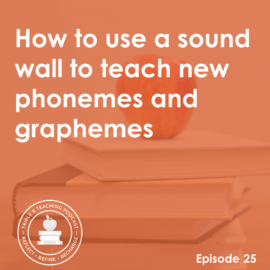
TRT Podcast#37: A simple look at how the brain learns to read
How exactly does the brain learn to read … and why should teachers even care? In today’s episode I simplify the science and share exactly why this understanding is important for K-2 teachers.
Listen to the episode here
Full episode transcript
Hello, Anna Geiger here, and I am continuing with our Facebook live series all about the science of reading! If you've been with me for the last couple of weeks, you've seen how I've talked about taking this big topic and breaking it down into little pieces. I'm doing it so they're not scary and so they show you what the science of reading is all about, and how it can help you improve what you're doing in the classroom.
This is Episode 37 of the Triple R Teaching podcast. If you're watching on Facebook, you're watching the live recording of what will become the episode when I put it on the podcast next week.
In today's episode, Episode 37, we're going to take a simple look at the brain and how it learns to read, and why this is even important. Why do you need to know it?
We're going to dive right in. What is the science of reading? The science of reading is a body of basic research on reading, and the research has been conducted for decades and has important implications for how we teach reading. I know a lot of people are hearing the phrase, "science of reading", and they think, what's that all about? Is it just another pendulum swing? Is this a brand new thing? It's actually been around for a long time, and we'll get into all of that in the next few weeks.
Last week, I told you that this week we were going to talk about the actual science, and I thought I was going to give an overview of all the pieces. Then as I started preparing it, I thought that's just a little too much to swallow at once! So we're going to take this piece by piece, and this week, we're just going to talk about the brain and how the brain learns to read.
Here's what we know about the brain and reading. Learning to read is not a natural process. So if you have ever read much about whole language or even been a whole language teacher, you may have heard that learning to read is natural - that if we surround children with the same things that we surround them with when they learn to speak, they'll learn to read. For example, if we're teaching kids to speak, we know that it's important to be talking to them, to surround them with language, and to have conversations. But many people have extended that over to the idea of teaching reading, and they say if we surround kids with lots of books and we read a lot to them, then they will naturally pick it up. Now, there are a small number of kids who do pick up reading without being directly taught, but it is only a small number, because the fact is, our brains were created to speak, and reading is a human invention.
So why is that important to know? Well, different parts of our brain work together as we read, so there's not one specific part of your brain that's the reading part. It's all different parts working together, and we have to train those parts of the brain to learn to read. The good news about the brain is it's able to change in order to learn new things. So when scientists look at the brain of someone with dyslexia, what they see is a brain that's not using all the parts efficiently. So the scientists say that our brains have plasticity. That means that a brain can be rewired, basically. This is good news for struggling readers. The right instruction can "rewire" the brain so that they can become good readers!
We know this stuff about the inside of the brain by using functional magnetic resonance imaging, FMRI, which you may be familiar with. Basically, it allows scientists to watch the neural systems at work as people read. So when you're using a part of your brain, more blood flow goes to that part. When they have people wear these special caps and sit in these little machines and they're reading, the scientists can look at their brain image and see which parts are basically lighting up. It reveals the parts of the brain that activate when we read.
Here's a picture of a brain here, and I promise you now, I'm going to get really, really, really basic. So I don't know about you, but I am not the kind of person who enjoys big technological explanations. My husband is really good at those, and my oldest son, who's 12 and just like him, is also really good at it, and both of them like to explain to me how things work. I usually start zoning out when they're telling me these things, because I just can't focus.
But if you're the kind of person who loves those big explanations, here's some really good books to check out. Mark Seidenberg's "Language at the Speed of Sight" has some good descriptions in there about how the brain learns to read. We've got "Overcoming Dyslexia" by Sally Shaywitz. Then we've also got "Reading in the Brain" - and I have tried so many times to remember how to pronounce his name - by Stanislas Dehaene. I may be wrong about that. But if you want the big, big specifics, these are what I recommend to you.
Let's go back, though, to my very simplified version. In the brain you could say we've got these parts that work together to read. You've got this part in the back. This is not the scientific name, but it's basically an orthographic processor, so it recognizes pictures, like letters and words. Then in the front of this left side of your brain, we've got the part that recognizes sounds, we could call it the phonological processor. Then kind of in the middle here, we've got the part that helps those two parts work together, and we could call it the phonological assembly region. It allows us to connect the speech sounds with the letters and the words.
This is all happening, as I said, in the left hemisphere, and that's really important to know. The left hemisphere is best designed for efficient reading. The reason why this is important to know is that in people who are struggling to learn to read, it's not happening in that part of the brain. It's happening on the other side! So if you're watching with me on Facebook, you can see this diagram of a brain of someone without dyslexia. You can see, as they're reading, that these parts are being activated. Scientists are finding that someone who has dyslexia when reading may not be activating this middle part very much, or this part over here in the back. Instead, what's happening is activity is going on in the other side of the brain, on the right side. That's what they're seeing in struggling readers. Their brains are not being efficient when it comes to reading, and it's slowing them down and impeding comprehension and all the rest.
So who cares? Why does this even matter? Why do I need to know how the brain learns to read? The reason that teachers should know this is because it has implications for teaching. Specifically, we have to know what to do to help this phonological assembly region get these other parts to work together. It's really important that we give the right instructions so that this develops! Otherwise, as I showed you in that other screen, we've got the two brains here, and someone with dyslexia isn't really using that middle part as much. We've got to figure out what to do to help them so that this part gets used more as they're reading.
So how do we do that? That's the big question, right? Well, some of you are not going to like my answer, and I know this because I did not like it myself! The answer is that the texts that we use are important. It means you cannot just be using leveled texts with brand new readers. If you are someone who does balanced literacy or guided reading, you may have been using levels like A, B, C, D with your early readers. Those books rely a lot on picture cues, so you might ask them what makes sense, what sounds right, and to use the picture. I've done that myself. I've told teachers to do that! But now I've realized that is NOT the best way to build that reading brain. It's not a good way at all, because instead of helping kids make connections between the letters themselves and the sounds, the phonemes, we're sort of asking them to do work in the right side of the brain. And that's what struggling readers do.
We want to help the left side of the brain have the right circuits firing when kids are reading, so we want to make sure that they're giving lots of practice reading decodeable texts. If that scares you, don't worry, because I'm going to talk about it in the future.
Our brains need explicit systematic phonics instruction and practice with decoding, not only in those decodable texts, but in our phonics lessons. If you're someone who's afraid of drill and kill, I'm totally with you there. I always have been afraid of it myself. I'm learning, though, that phonics instruction does not have to be drill and kill. It can actually be a lot of fun, as long as we figure out exactly what our students need to know and we have the right materials to do it.
Those are definitely things we're going to be addressing in future episodes of the podcast. I want to sum up really quickly what we talked about today. We were born to talk, but our brains were not created to read. Reading is a human invention, and we must train parts of our brain to read. The left hemisphere is the part of the brain best suited for reading. When weak readers read, we often see more activity in the right side of the brain, which is not what we want. So we want to train that left side of the brain with explicit systematic phonics instruction.
Now, today I talked to you about neuroscience, and that is only one small piece of the science of reading. There's a lot of other things to talk about, specifically the simple view of reading and Scarborough's reading rope. Those are things we'll be getting to in the next couple of weeks, but I didn't want to overload you with too much at once! I just wanted to give you a really simple look at how the brain learns to read and why our instruction is so important.
If you have questions about this or other comments, and if you're listening on the podcast, you can head to the show notes, themeasuredmom.com/episode37, to give me some feedback. I'm definitely interested in what you're thinking.
Thanks so much for listening, and I'll talk to you again next week.
Sign up to receive email updates
Enter your name and email address below and I'll send you periodic updates about the podcast.
Recommended reading
- Language at the Speed of Sight, by Mark Seidenberg
- Overcoming Dyslexia, by Sally Shaywitz
- Reading in the Brain, by Stanislas Dehaene
Link to original Facebook Live presentation
Check out the full science of reading bootcamp
- Introduction to the series
- Episode 1: What are the reading wars?
- Episode 2: My reaction to the article that reignited the reading wars
- Episode 3: How the brain learns to read
- Episode 4: What the science of reading is based on
- Episode 5: What’s wrong with three-cueing?
- Episode 6: Should you use leveled or decodable books?







Juhi
Very informative!
Thank you!
Anna Geiger
Thanks for listening, Juhi!
Cari
After this podcast I’m even more worried about how we’ve
been teaching our virtual learners! Time to reinvent things AGAIN! Any suggestions for virtually introducing preschoolers to reading without as many pictures?
Anna Geiger
Hi Cari! I know that virtual learning is tough! I would do phonological/phonemic awareness activities virtually, which are very easy to do and are a great foundation for beginning reading! You can get a free and quality curriculum here: https://www.readingdoneright.org/programs-by-grade
Jessica Hicks
How may get started on reading much more bigger words ones I haven’t seen before such as in books or journals too and trying to pronounce them with out trying to have any help from any only first but some of the reading is kinda easy and some is a real challenge for me to so when I even haven’t seen the word or even had it as an spelling word.
Anna Geiger
I’m not sure what you’re asking, Jessica; could you rephrase your question?